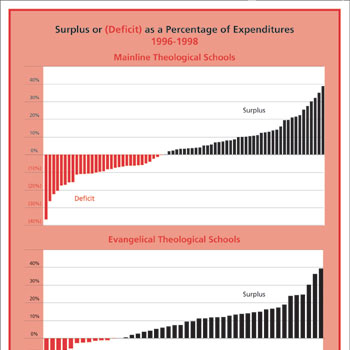By erasing up to half of a student’s $11,000 tuition, the Aquinas School of Theology in St. Louis has been able to double its enrollment in just eight years. The strategy of giving these “board grants” to qualified applicants isn’t the only stimulant, of course, but it has been a major factor.
As Aquinas’s president, the Reverend Charles Bouchard, O.P., explained, the school has a solid source of tuition income from thirty-five seminarians whose dioceses pay full fare. The other 240 candidates for a variety of degrees boost those revenues even if they receive large tuition discounts. The logic is simple. “Board grants generate 50 percent of revenue rather than nothing,” Bouchard said. For the past four years, Aquinas has harvested surpluses.
Similar strategies have been adopted by a wide variety of theological schools as a tactic similar to those used by colleges and universities. A recent study of the undergraduate side by the Lumina Foundation found little gain and much risk in the practice.
Like the undergraduate institutions, theological schools have set money aside for scholarships based on standards other than financial need: chiefly, grades and character. In some cases, the goal is to keep the number of students at an adequate level. In others, the aim is to entice students with academic promise or the potential for church leadership. This aid goes by many names: tuition grants, tuition discounts, special fellowships, and merit scholarships among them. What they have in common is that they are outright awards that don’t have to be paid back.
A less obvious benefit is that a merit grant can allow part-time students to pursue full-time studies. The struggle of many older students to attend classes while earning a living can produce dropouts or marathon courses of study. The discount banners are flying high.
Competing for the Best
Pittsburgh Theological Seminary, for example, took out an ad in the April 11 issue of The Christian Century to pledge its “ongoing commitment to both merit scholarships and need-based assistance” under the slogan, “Deciding to go to seminary might keep you awake at night. Paying for it shouldn’t.”
The following week, United Theological Seminary in the Twin Cities posted a notice in the Century which assured applicants that “need-based, merit, and leadership scholarships which can provide up to full tuition are available.”
Prompting this drive are basic survival instincts: keeping students coming through the doors and finding those with intellectual quality. Some school officials say merit awards have become more crucial in inducing top students to try seminary and in luring applicants away from other schools.
Many faculty and officials tie the campaign for more highly qualified students to a need to raise the educational standards of the schools. A recent study for the Fund for Theological Education conducted by Barbara G. Wheeler, president of Auburn Theological Seminary, indicates room for improvement. It found the median acceptance rate for theological schools to be 87 percent (by definition, half were higher), and that most students applied to only one school.
Statistics are lacking on how many theological institutions give merit aid, but Anthony T. Ruger, a senior research fellow at Auburn’s Center for the Study of Theological Education, believes that it has become widespread among seminaries of all types—and it is growing. Donors like to give to a fund that supports recruiting the best and the brightest, Ruger said, while professors tout the benefits of attracting brainy students. The prospect of a brain gain is costly.
Ruger and Wheeler, in their report on theological schools’ finances, “The Big Picture,” note the “increasing financial competition for certain students. Special awards and scholarships are increasing in number and amount. These awards—often for full tuition plus books and other expenses—are designed to attract prospective students thought to be highly capable. It is not unusual for a gifted applicant to receive several of these merit scholarships from competing schools.”
Becoming a “competing school” takes money, of course. The schools with the deepest pockets clearly have an advantage. Of the dozens of schools analyzed by Ruger and Wheeler for “The Big Picture,” only a small fraction—eleven mainline, three Roman Catholic, and two evangelical schools—were rated as wealthy “Goliaths” that, the report said, could compete “in bidding for students with special scholarships.”
Given the difficulty of finding enough students to keep enrollment stable, and the tendency of applicants to look at only one school, even well-heeled institutions sometimes have trouble spending all the money they have set aside for tuition assistance. Recruitment has become a pressing need.
Does It Work?
Money may not rate as a very strong incentive among many applicants. “There is no objective research in the field of theological education that measures the extent to which a school can ‘buy’ a student body,” Wheeler and Ruger wrote. “Some schools with extremely generous financial aid struggle for students, while others, with very limited grants, are flourishing. These and other stories suggest that some students may be persuaded to attend a particular school because of financial aid, but that most students are relatively unswayed by personal finances in the selection of a school.”
Another note of caution comes from the Lumina study of undergraduate merit aid. The report warns that institutions which rely too heavily on merit assistance risk losing critical amounts of tuition income. That loss, in turn, threatens the institution’s economic stability. The Lumina report also claims that the quality of students, as measured by standardized tests, generally did not improve significantly as a result of the practice it calls “tuition discounting.”
Ruger thinks he has detected a drawback in theological schools themselves. While the presidents, deans, and others “at the top” of the school sing the praises of merit grants, students “down below” don’t always cheer. Students are often fuzzy about the standards for qualifying or how to apply, he says. “If I’m a student for the ministry, and the person to the left of me has a merit scholarship,” Ruger said, “and the person on my right has a merit grant and is thinking of a journalistic career, I might feel resentful.”
More Grants Ahead?
Despite the pitfalls, Ruger and other seminary analysts believe merit grants will expand in the years ahead. Once momentum has set in, they point out, it tends to pick up steam. Among undergraduate institutions, the practice swelled during the 1990s as a competitive tool for wooing students. If one school began offering such inducements, neighboring schools felt compelled to match them. One result was a flood of merit grants to families at higher and higher levels of income.
But signs of a backlash are surfacing. Recently a group of twenty-eight noted colleges and universities including Stanford, Yale, Columbia, and Swarthmore declared that they would shift financial aid away from affluent students, who are often highly desired for their academic achievement, and direct more support to truly needy students. The purpose of this effort, its leaders said, was to turn back the trend that had been steering more and more money to the well-heeled.
Theological schools generally lack the financial resources to lavish scholarships on “desirable” students regardless of need. They also experience less competition for students. Many seminaries face a delicate balancing act, however.” The Big Picture” puts it this way: A theological school’s “pricing decision—how much to charge for a degree and how much to discount the price through financial aid grants—seeks to accomplish two goals that are at odds with one another. One goal is to set rates of tuition and financial aid that will attract students on the basis of price and net cost. The other is to increase net revenue for the school.”
Without a superb academic reputation, the report adds, any amount of money spent any which way cannot bring them in.
Resources
The Big Picture: Strategic Choices for Theological Schools, by Anthony T. Ruger and Barbara G. Wheeler. Auburn Studies, December 2000. The text can be downloaded from the Auburn Theological Seminary’s web site www.auburnsem.org/studies/7_picture. Single copies are available without charge from Auburn Theological Seminary, 3041 Broadway, New York, NY 10027.
Discounting Toward Disaster: Tuition Discounting, College Finances, and Enrollments of Low-Income Undergraduates, by Kenneth E. Redd. USA Group Foundation: New Agenda Series. Volume III, Number 2, December 2000. The publisher is now known as the Lumina Foundation. The text can be downloaded from its web site https://www.luminafoundation.org/Publications/new_agenda.shtml.
“Fit For Ministry?”, by Barbara G. Wheeler, Christian Century, April 11, 2001. This article is a useful report on the characteristics of students currently entering theological schools.
The full report, Is There a Problem? Theological Students and Religious Leadership for the Future, can be downloaded from <https://www.auburnsem.org/studies/8_problem/>.




























